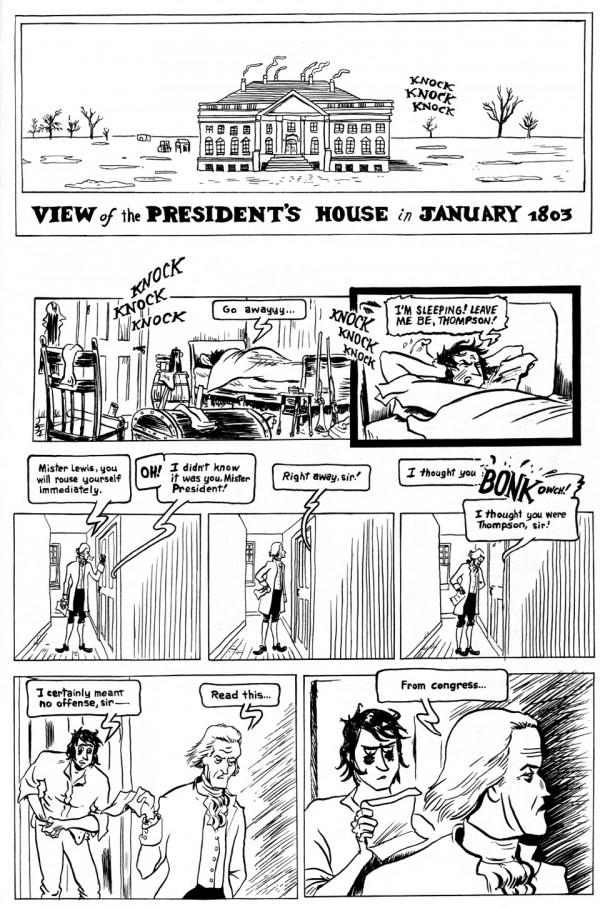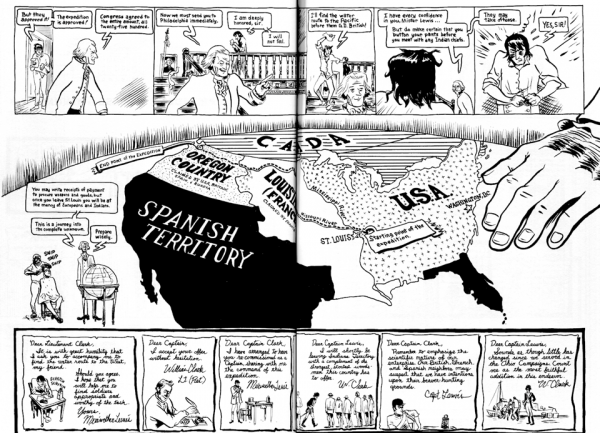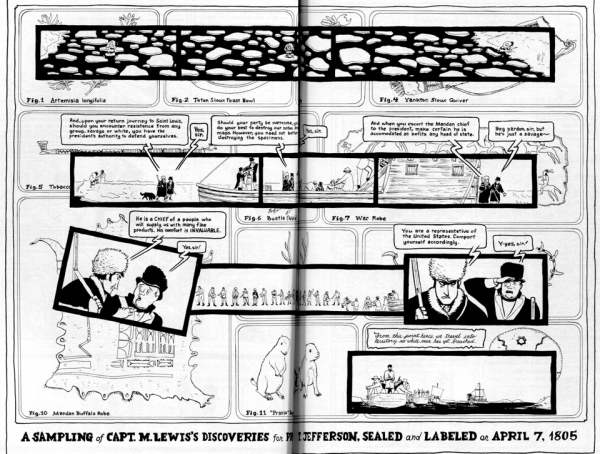
 Lewis & Clark by Nick Bertozzi (First Second, 2011)
Lewis & Clark by Nick Bertozzi (First Second, 2011)
Nonfiction comics are always a mixed bag, and my beef is that, for the lion’s share of them, the comic format is simply a novelty to be draped over some information; it’s a spoonful of sugar to take with your medicine. Instead of cursing the darkness, though, I’d like to hold a candle to one of my favorite examples of historical comics: Nick Bertozzi’s Lewis & Clark.
Never heard of it? It probably got lost in the waves of boring, educational comics I mentioned above. Amazon recommends it for ages 12-17, and the book’s cover blurb is a symptom of that kind of thinking; from the venerable Ken Burns, we see that this book is “[a] wonderful introduction to one of the most important expeditions and dramatic stories in American history.” It’s not the dramatic story—it only serves as an introduction.
Obviously, I think Lewis & Clark is a bit more than an introduction to the historical expedition. It’s closer to a biography of Captain Merriwether Lewis and a devastating portrait of manic depression. But it’s fun! And exciting! If someone told me a comic was “a devastating portrait of manic depression,” I’d steer clear, but I promise this book is worth it. The narrative is cunningly crafted, and Bertozzi takes advantage of the comic medium in ways both subtle and flamboyant.
A dry, didactic introduction to this important expedition might start with some historical context. It might establish what was happening in the United States and France or elucidate the borders of the fledgeling U.S. Instead, we’re introduced to the moody yet sedentary Merriwether Lewis. Bertozzi shows us right away who his story is focusing on.
He also isn’t lazy about setting the scene. A lesser cartoonist sticks a small narrative box in the corner above Lewis to tell us where and when we are. Bertozzi gives us a lovingly lettered postcard of the president’s home, simultaneously teaching us how he’s going to take us from scene to scene.
Bertozzi doesn’t skimp on the context and the elucidation, though—he doesn’t sacrifice history for character development. He just informs us in a way that expands on character. We don’t get a map; we get a close-up on a globe, Jefferson’s hand resting in the east. It’s a calm hand, but it’s also huge and a little threatening. In the background, Lewis gets a haircut. It’s a sad man who needs other men to prompt him towards grooming.
This foregrounding of Lewis’s personality over the intricacies of the expedition and the quirks of the period is illustrated quite literally in one case:
The facts and the methods, illustrated in the background, are interesting, but an explanation of what they mean might be more fitting for a textual analysis. It’s the personality and the human element that Bertozzi captures best with his thick, loose line. The pages above show him getting the best of both worlds: the collection and display of objects and facts, like a comic book Wunderkammer, along with the primal emotion that cartooning does so well.
While Lewis is central to the arc that Bertozzi’s constructed, everyone gets a bit of definition, and it’s Bertozzi’s familiarity with the tools of comic storytelling that make this possible. For instance, this book is a showcase for thoughtful, deliberate lettering. Each specific language is rendered in a different style, intuitively signalling the change in tongue without needing intrusive footnotes.
The biggest evidence for this being the story of temperamental Merriwether Lewis’s comes about a third of the way through the book with the first sighting of the Pacific. It’s given a bit of visual weight, but not more than any other location the Corps of Discovery visits. Two pages are devoted to Sacagawea’s peaceful exploration of the beach, but Lewis has an entirely different reaction: the achievement sends him into another deep malaise similar to how he was when the book began.
Why? What’s the source of Lewis’s emotional rise and fall? The people around him call him “temperamental” and “dark,” and Bertozzi is smart enough to let that stand as the sole diagnosis. His moods are mysterious and sudden, and the most definition they get is when Bertozzi illustrates them as ominous shadows just out of reach.









